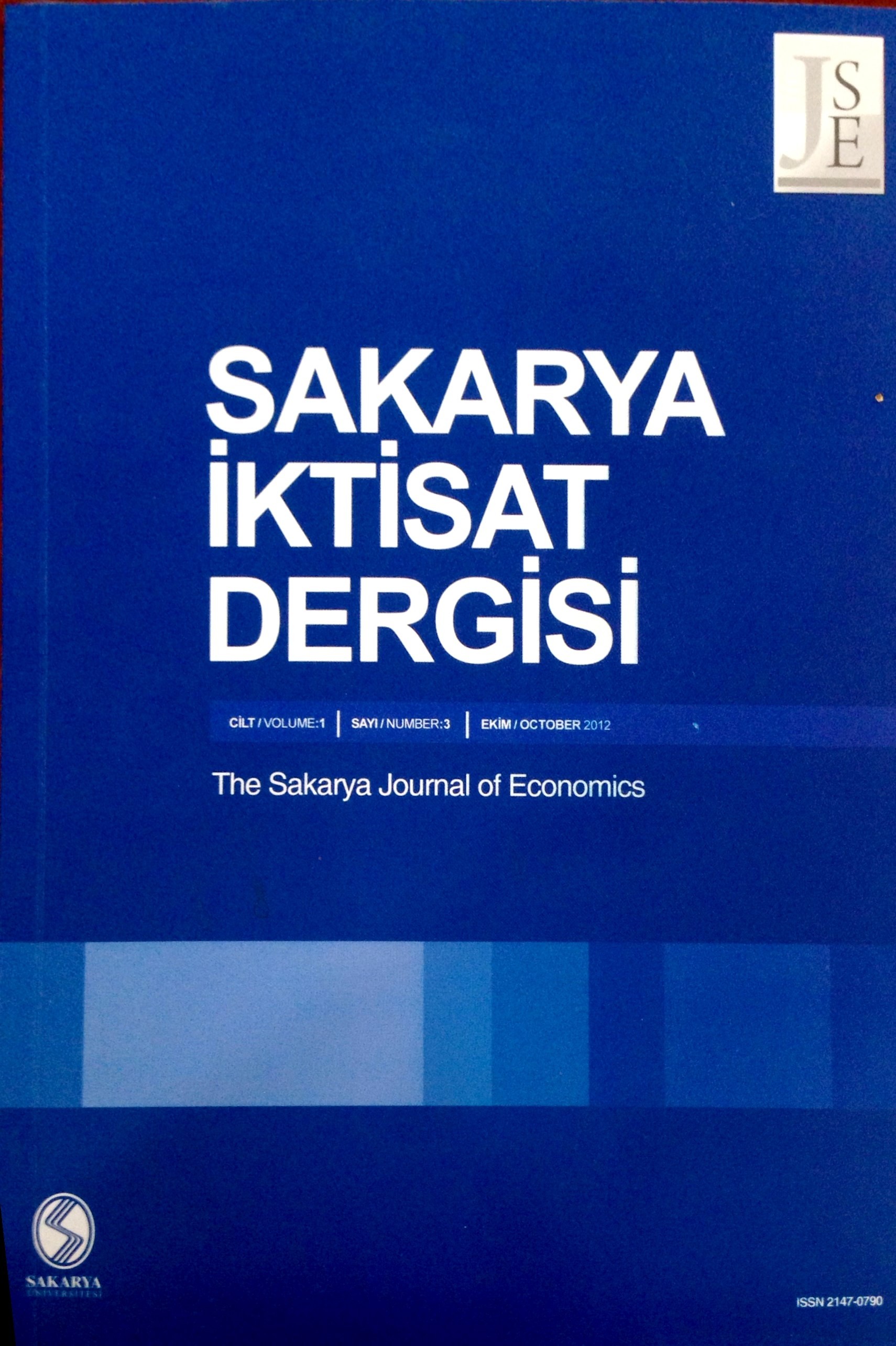EFFECTS OF GERMAN-TURKISH INDUSTRIAL POLICIES ON MANUFACTURING INDUSTRY COMPETITIVENESS
Industrial Policy, Revealed Comparative Advantage Index, Germany
EFFECTS OF GERMAN-TURKISH INDUSTRIAL POLICIES ON MANUFACTURING INDUSTRY COMPETITIVENESS
Industrial Policy, Revealed Comparative Advantage Index, Germany,
___
- AKKOYUNLU, A. & MIHCI, S. (2006): ‘‘Effects of Customs Union with European Union on the Market Structure and Pricing Behaviour of Turkish Manufacturing Industry’’, Applied Economics, Vol.: 38, Issue: 20.
- ALTAY, B. & GURPINAR, K. (2008): ‘‘Açıklanmış Karşılaştırmalı Üstünlükler ve Bazı Rekabet Gücü Endeksleri: Türk Mobilya Sektörü Üzerine Bir Uygulama’’, Afyon Kocatepe Üniversitesi, İ.İ.B.F Dergisi, Cilt:10, Sayı: 1, 2008, s. 257-274.
- ATIYAS, İ. & BAKIS, O. (2015): ‘‘Structural Change and Industrial Policy in Turkey’’, Emerging Markets Finance and Trade, Vol.: 51, Issue: 6, pp. 1209-1229.
- BALASSA, B. (1965): ‘‘Trade Liberalisation and ―Revealed‖ Comparative Advantage’’, The Manchester School, Vol.: 33, Issue:2, pp. 99-123.
- BANGER, G. (2016): Endüstri 4.0 ve Akıllı İşletme, Ankara, Dorlion Yayınları.
- BARTHOLOMAE, F. W. (2018): ‘‘Ökonomische Auswirkungen der Digitalisierung auf den internationalen Wettbewerb und die internationale Arbeitsteilung’’, Volkswirtschaftliche Diskussionsbeiträge, Universität der Bundeswehr München.
- BULUT, E. & AKCACI, T. (2017): ‘‘Endüstri 4.0 ve İnovasyon Göstergeleri Kapsamında Türkiye Analizi‘‘, ASSAM Uluslararası Hakemli Dergi, Sayı.:7, s. 50-72.
- DOGRU, B.N. & MECIK, O. (2018): ‘‘Türkiye‘de Endüstri 4.0‘ın İşgücü Piyasasına Etkileri: Firma Beklentileri‘‘, Süleyman Demirel Üniversitesi İktisadi ve İdari Bilimler Fakültesi Dergisi, Cilt: 23, s. 1581- 1606.
- EGILMEZ, M. (2018): Tarihsel Süreç İçerisinde Dünya Ekonomisi, İstanbul, Remzi Kitabevi, 2018.
- ERBER, G. (2016): ‘‘Industrial Policy in Germany after the Global Financial and Economic Crisis’’, SSRN Electronic Journal, pp. 1-38.
- FERTÖ, I. & HUBBARD, L.G. (2003): ‘‘Revealed Comparative Advantage and Competitiveness in Hungarian Agri–Food Sectors’’, The World Economy, Vol.:26, Issue: 2, pp. 247-259.
- HINLOOPEN, J. & MARREWIJK, C. (2001): ‘‘On the empirical distribution of the Balassa index’’, Weltwirtschaftliches Archiv, Vol.:137, Issue:1, pp.1-35.
- ILO: ‘‘Annual growth rate of output per worker (GDP constant 2010 US $)’’, (Online) https://www.ilo.org/shinyapps/bulkexplorer1/?lang=en&segment=indicator&id=SDG_A821_NOC_RT_A, 15.07.2020.
- INVESTOPEDIA: ‘‘Business: Business Essentials: Why You Should Invest in Research and Development (R&D)’’, (Çevrimiçi) https://www.investopedia.com/ask/answers/043015/what-arebenefits-research-and-development-company.asp, 10.08.2020.
- KHATIBI, A. (2008): ‘‘Kazakhstan's revealed comparative advantage vis-à-vis the EU-27’’, ECIPE Working Paper, No. 03/2008, European Centre for International Political Economy (ECIPE), Brussels, 2008.
- KOC, E. & ET AL. (2018): ‘‘Dünyada ve Türkiye‘de Sanayileşme I - Strateji ve Temel Sanayileşme Sorunları’’, Mühendis ve Makina, Cilt: 59, Sayı: 690, s. 1-26.
- KOC, E. & ET AL. (2017): ‘‘Türkiye‘de Ekonomik Göstergeler - İmalat Sanayi Kapasite Kullanım Oranı’’, Mühendis ve Makina, Cilt: 58, Sayı: 689, 2017, s. 1-22.
- KOSE, A & ONCU A. (2000): ‘‘İşgücü piyasaları ve uluslararası işbölümünde uzmanlaşmanın mekânsal boyutları: 1980 sonrası dönemde Türkiye imalat sanayii’’, Toplum ve Bilim, Sayı: 86, s. 72-90.
- KRZYWDZINSKI, M. (2016): ‘‘Technologie, Qualifikationen und internationale Arbeitsteilung: Anmerkungen zu der Diskussion über Industrie 4.0’’, Wissenschaftszentrum Berlin für Sozialforschung (WZB), WZB Discussion Paper, No. SP III 2016-301, Berlin.
- LALL, S. (2000): ‘‘The Technological Structure and Performance of Developing Country Manufactured Exports, 1985-1998’’, QEH Working Paper Series, Number:44..
- LIPIETZ, A. (1998): Nach dem Ende des Goldenen Zeitalters: Regulation und Transformation kapitalistischer Gesellschaften, Ed., Hans Peter Krebs, Berlin-Hamburg, Argument Verlag.
- MINISTRY OF DEVELOPMENT (2013): Onuncu Kalkınma Planı 2014-2018, Ankara.
- NAYAK, S. & ET AL. (2013): ‘India‘s Manufacturing Exports Dynamics: An Analysis of Technology Intensity Transition’’, Working Paper, Indian Institute of Foreign Trade: Centre for WTO Studies (CWS), New Delhi, pp. 1-36.
- OECD: ‘‘Business enterprise R&D expenditure by industry’’, (Online) https://stats.oecd.org/Index.aspx?DataSetCode=BERD_INDU, 03.06 2020
- OECD: ‘‘Employment by Activity‘‘, (Online) https://data.oecd.org/emp/employment-by-activity.htm, 15.08.2020.
- OECD: ‘‘GDP per hour worked’’, (Online) https://data.oecd.org/lprdty/gdp-per-hour-worked.htm, 10.06.2020 data.
- OECD: ‘‘Industrial production: Manufacturing’’, (Online) https://data.oecd.org/industry/industrial-production.htm, 07.06.2020.
- PORTER, M.E. (1990): Competitive Advantage of Nations, New York, The Free Press. SANDALCILAR, A.R. & YALMAN, İ.N. (2012): ‘‘Türkiye‘de Dış Ticaretteki Serbestleşmenin İşgücü Piyasaları Üzerindeki Etkileri’’, Eskişehir Osmangazi Üniversitesi İİBF Dergisi, Cilt: 7, Sayı: 2.
- SCHOBER, K.S. (2017): ‘‘Industry 4.0 – Challenge for the F&B industry in Turkey, advantage or competitive disadvantage?‘‘, Roland Berger –Siemens Digitalization in Food & Beverage Presentation, Istanbul, (Online) https://www.siemens.com.tr/i/Assets/gidagunu/170524_KS_Industrie40_Presentation_Siemens_Turkey.pdf
- SHAHAB, S. & MAHMOOD, M.T. (2013): ‘‘Comparative Advantage of Leather Industry in Pakistan with Selected Asian Economies’’, International Journal of Economics and Financial Issues, Vol.: 3, No: 1, pp. 133-139.
- SOYAK, A. (2015): ‘‘Avrupa Birliği Sürecinde Türkiye Sanayi Politikası Üzerine Eleştirel Bir Yaklaşım’’, TMMOB Ölçü Dergisi, s. 61-69.
- THE WORLD BANK:, ‘‘Manufactures exports (% of merchandise exports)”, (Online)https://data.worldbank.org/indicator/TX.VAL.MANF.ZS.UN?locations=DE-TR, 10.07.2020
- THE WORLD BANK: Manufacturing, value added (% of GDP) '' (Online) https://data.worldbank.org/indicator/NV.IND.MANF.ZS?end=2018&locations=TR-DE&start= 1960 & view = chart, 05.04.2020.
- TUNA, O. & YALCINTAS, N. (1999): Sosyal Siyaset, İstanbul, Filiz Kitabevi.
- TUREK, J. (2016): ‘‘Industriepolitik‘‘, Jahrbuch der Europäischen Integration 2016, Ed., Werner Weidenfeld und Wolfgang Wessels, Baden-Baden, s. 259-262.
- UN Comtrade Database: (Online) https://comtrade.un.org/data/, 10.07.2020 data.
- URAS, G. (2017): Sanayileşecektik Büyüyecektik N’oldu Bize, İstanbul, Doğan Kitap.
- VDA (2019): ‘‘Economic Policy and Infrastructure: Trade’’, (Online), https://www.vda.de/en/topics/economic-policy-andinfrastructure/trade/importance-of-trade-policy-for-industryand-for-germany-as-an-industrial-location.html, 20.06.2020..
- WIEGAND, B. (2018): Der Weg aus der Digitalisierungsfalle: Mit Lean Management erfolgreich in die Industrie 4.0, Wiesbaden, SpringerGabler.
- WORLD TRADE ORGANIZATION (2019): World Trade Statistical Review.
- ISSN: 2147-0790
- Yayın Aralığı: Yılda 4 Sayı
- Başlangıç: 2012
- Yayıncı: Sakarya Üniversitesi
GELENEKSEL OLMAYAN PARA POLİTİKASI KAPSAMINDA FİNANSAL İSTİKRAR: TEORİK BİR İNCELEME
Şuayyip ÇALIŞ, Şule AYDIN TURAN, Sevgi DÖNMEZ MAÇ, Emrullah TAN
KOSGEB UYGULAMALI GİRİŞİMCİLİK EĞİTİMLERİNİN ANALİZ EDİLMESİ: BİLECİK ÖRNEĞİ
Gürkan HAŞİT, Necati ÇİFTÇİ, Sevgi GÖNÜLLÜOĞLU, Mustafa ARI, Bülent TURAN
KAPSAYICI BÜYÜMENİN ÖLÇÜLMESİ: TÜRKİYE ÖRNEĞİ
Pelin KARATAY GÖGÜL, Demet YAMAN
İTHALATIN EKONOMİK BÜYÜMEYLE OLAN İLİŞKİSİ
Adnan DOĞRUYOL, Zeliha POLAT, Selahaddin KUTLAR
NEOLİBERAL EKONOMİ-POLİTİK DÜZENİN TARIM POLİTİKALARI ÜZERİNE BİR DEĞERLENDİRME
Mustafa Kemal AYDIN, Mehmet Ali BACAKSIZ
Hamdi Furkan GÜNAY, Uğur UYĞUN, Fatih YARDIMCIOĞLU
EFFECTS OF GERMAN-TURKISH INDUSTRIAL POLICIES ON MANUFACTURING INDUSTRY COMPETITIVENESS
